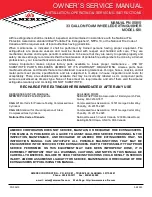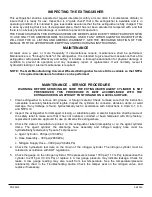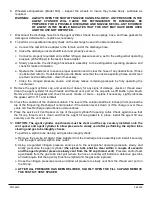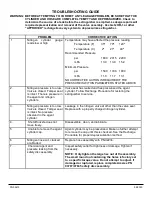
PN 05615
04/2020
6.
Wheeled extinguishers (Model 630) –
Inspect the wheels to insure they rotate freely. Lubricate as
required.
WARNING:
ALWAYS OPEN THE SHUTOFF NOZZLE HANDLE SLOWLY. ANY PRESSURE IN THE
AGENT CYLINDER WILL CAUSE THE EXTINGUISHER TO DISCHARGE. BE
PREPARED FOR A POSSIBLE DISCHARGE AND NOZZLE RECOIL. ANY EVIDENCE
OF AGENT IN THE NOZZLE INDICATES THAT THE UNIT MAY HAVE BEEN USED
AND THE USE NOT REPORTED.
7.
Disconnect the discharge hose from the agent cylinder. Check the couplings, hose, and hose gaskets for
damage or deterioration –
replace as necessary.
8.
To perform an operational integrity check on the discharge hose and nozzle combination:
a.
Connect the test kit hose adapter to the female end of the discharge hose.
b.
Close the discharge nozzle shutoff lever and properly secure it.
c.
Connect a properly regulated and verified nitrogen pressure source, set to the extinguisher operating
pressure (235
-
245 psi) to the test kit hose adapter.
d.
Slowly pressurize the discharge hose/nozzle assembly to the extinguisher operating pressure and
check for leaks or distortion.
e.
Operate the nozzle lever to ensure proper operation and to clear the hose of any obstructions. If hose
is obstructed refer to Troubleshooting Guide. Make sure that the nozzle aspirating holes and screen
are clear and unobstructed –
clean if necessary.
f.
Close the nitrogen pressure source, and slowly relieve remaining pressure by fully operating the
nozzle lever.
9.
Remove the agent cylinder cap, and examine it closely for any signs of damage, cracks or thread wear.
Clean the agent cylinder fill cap threads and thread vent port on the cap with a stiff bristle nylon brush.
Remove the fill cap gasket and check for wear, cracks, or tears –
replace if necessary. Lightly lubricate
the gasket with V
-
711 and reinstall.
10.
Check the condition of the chemical solution. The level of the solution shall be 9 inches (23 cm) below the
top of the fill opening. Recharge if contaminated, if the solution level is down or if the charge is over three
years old. See Recharge instructions and procedures.
11.
Place the service kit Vent Spacer on top of the agent cylinder fill opening collar. Check again to see that
the fill cap thread vent is clean and that the agent fill cap gasket is in place. Install the agent fill cap
securely over the vent spacer.
12.
CAUTION: The agent cylinder cap threads must be clear and the cap securely installed onto the
vent spacer and agent cylinder to allow pressure to slowly vent after performing the siphon tube
clearing and gas tube integrity checks.
To perform a siphon tube clearing and gas tube integrity check:
a.
Remove the service kit Agent Hose Adapter from the discharge hose assembly and install it securely
onto the agent cylinder siphon tube outlet.
b.
Using a regulated nitrogen pressure source set to the extinguisher operating pressure, slowly and
briefly pressurize the agent cylinder (
the siphon tube shall be clear within a couple of seconds
and the agent cylinder pressure slowly vent from the fill cap thread vent)
. Pressure and/or foam
agent leaks from the gas tube inlet port (where the hose connects) will indicate a defective gas tube
and will require that the agent cylinder be emptied and the gas tube replaced.
c.
Close the nitrogen pressure source and allow all pressure to slowly vent from the thread vent port on
the fill cap.
d
.
AFTER ALL PRESSURE HAS BEEN RELIEVED, SLOWLY OPEN THE FILL CAP AND REMOVE
THE TEST KIT VENT SPACER
.










